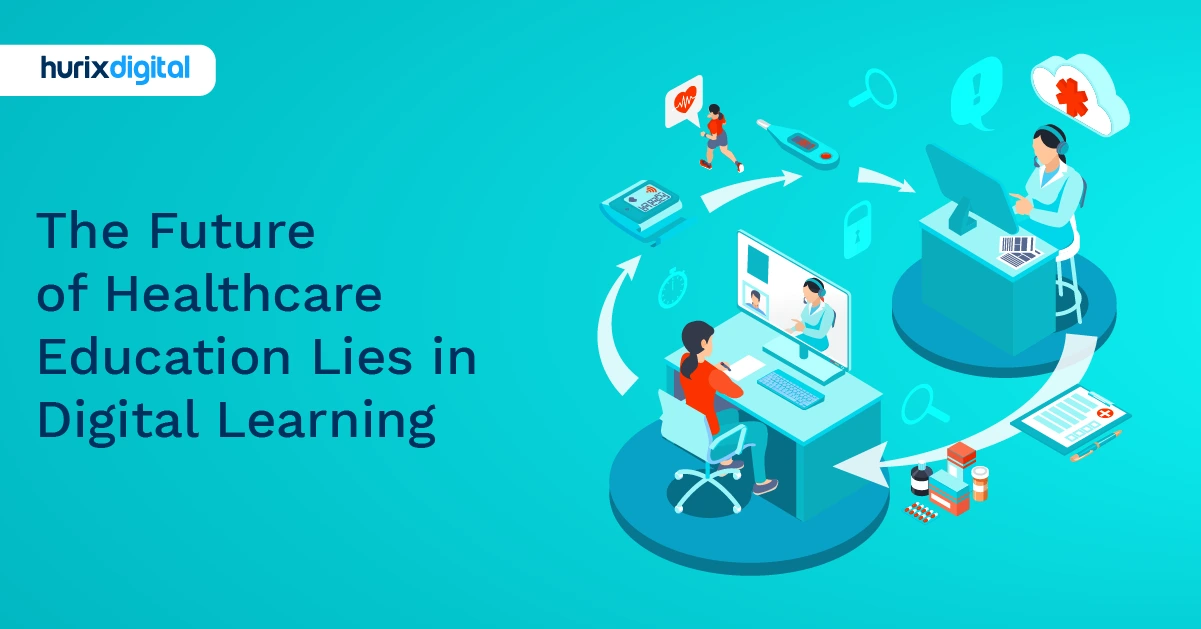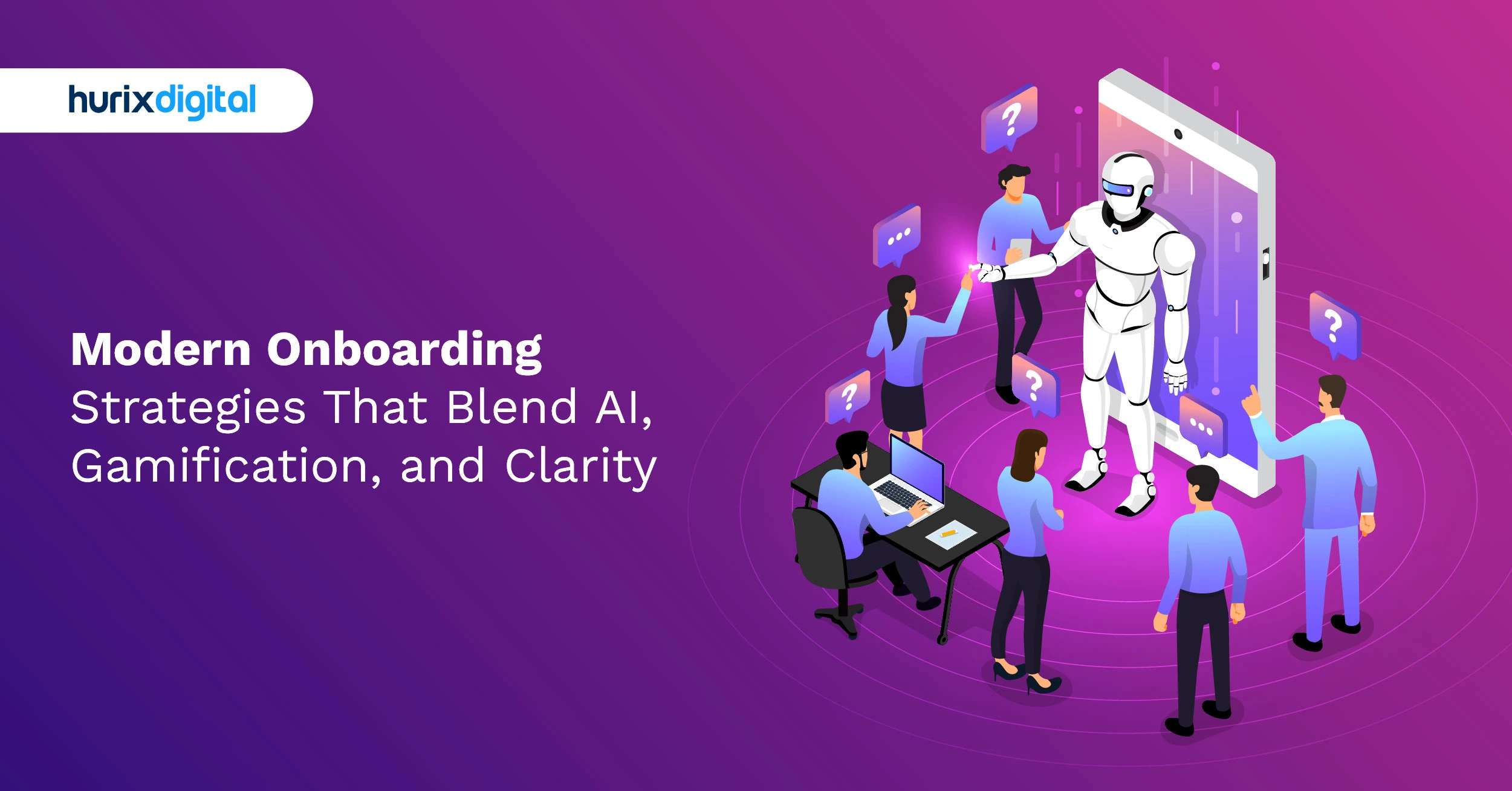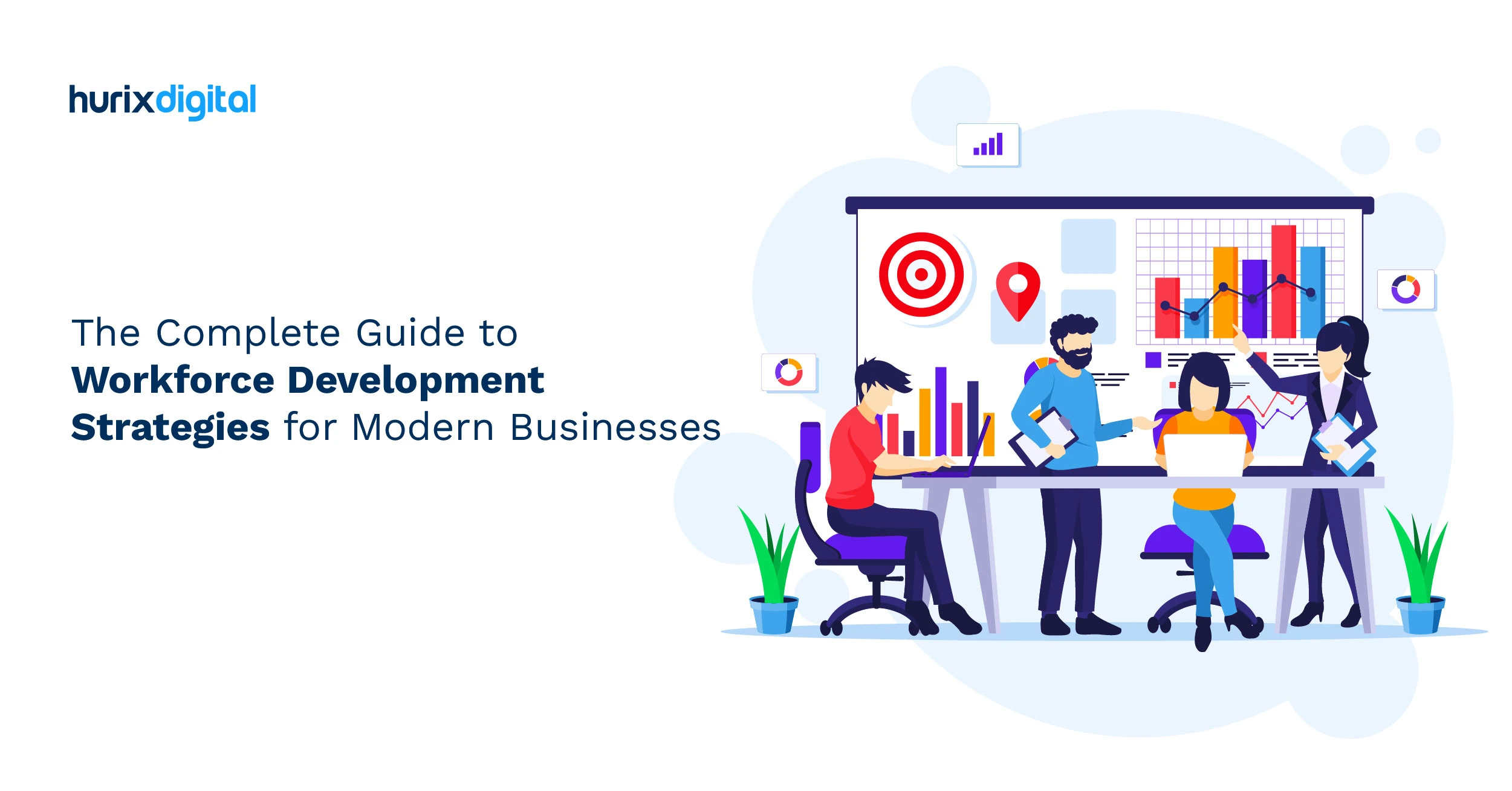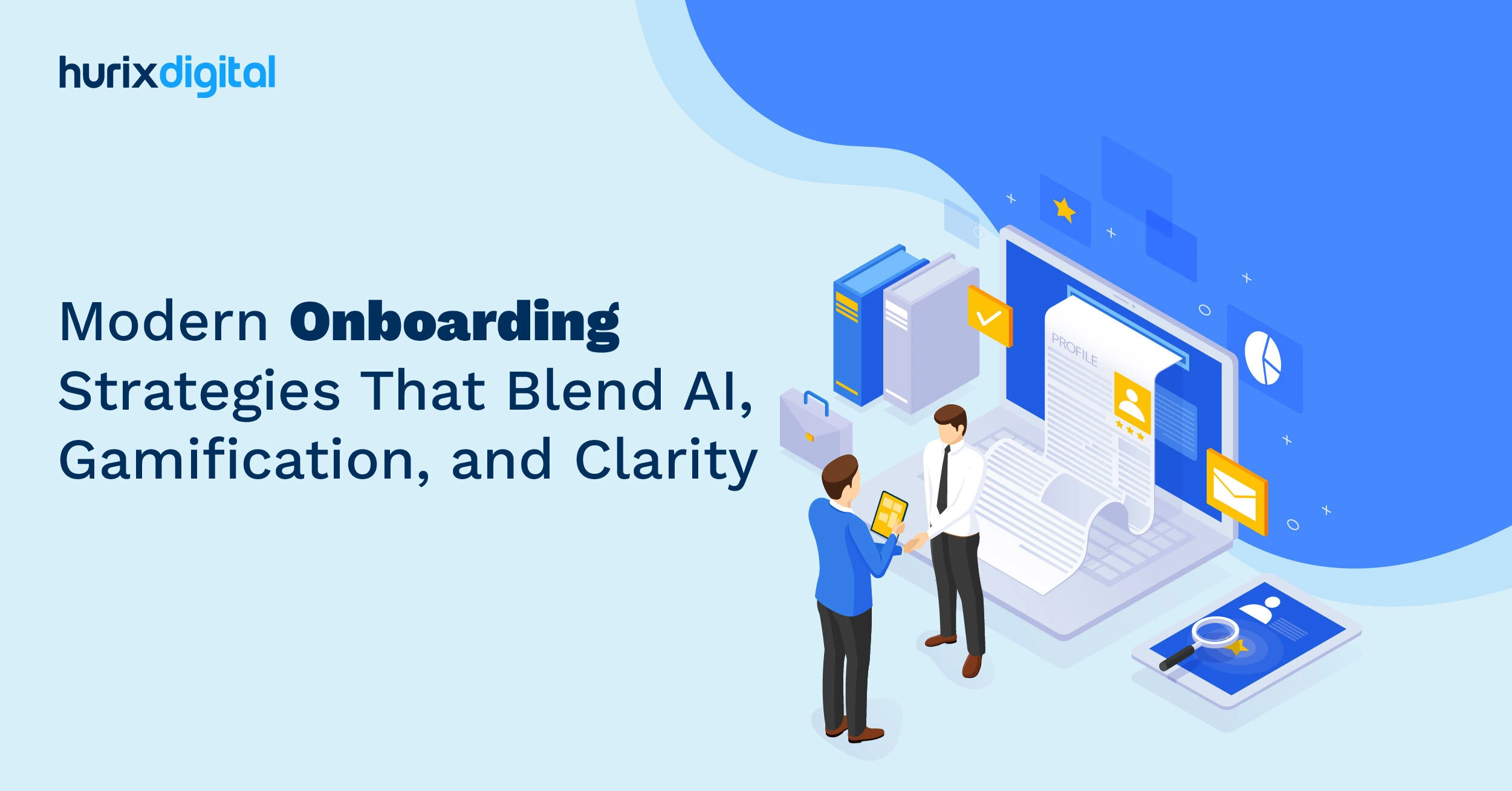
Modern Onboarding Strategies That Blend AI, Gamification, and Clarity
Summarize with:
This blog explores the exciting ways AI and gamification are reshaping the employee onboarding process. By automating workflows, enhancing engagement, and crafting clear 30-60-90 day plans, you’ll discover how to build a smooth, effective, and forward-thinking onboarding experience that prepares new hires for lasting success.
Employee onboarding is a critical process that sets the tone for an employee’s entire tenure at a company. It is the first opportunity to showcase the company culture, demonstrate the core values, and build rapport between the new hires and their colleagues.
However, traditional onboarding methods can be tedious, time-consuming, and ineffective, leading to high turnover rates, low productivity, and poor employee satisfaction. That’s where tech-powered onboarding comes in. By leveraging the latest AI-driven tools and gamification techniques, companies can enhance the onboarding experience and make it more engaging, interactive, and personalized.
The global onboarding software market is estimated to be worth $1.7 billion in 2026, and for good reason. With technological advancements occurring at warp speed, corporations can now use AI to streamline and enhance the onboarding experience for new employees.
In this blog, we will explore how tech can enhance the onboarding process for your employees. Read on!
Table of Contents:
- What Does the 30-60-90 Day Onboarding Process Refer To?
- Should Onboarding Be Automated?
- Pros and Cons of Automation
- How Do You Automate an Onboarding Process?
- The Benefits of Tech-Powered Onboarding
- The Role of AI in Onboarding Automation
- The Power of Gamification in Employee Training
- Best Practices for Tech-Powered Onboarding
- How to Design a Well-Thought 30-60-90-Day Plan?
- The Future of AI in Employee Onboarding
- Conclusion
What Does the 30-60-90 Day Onboarding Process Refer To?
Onboarding doesn’t mean signing new hires’ paperwork and then taking them to their workstation without any communication. This will make them feel disoriented about their role and undervalued. As a result, most employees leave the job within the first 44 days.
That’s where a 30-60-90 day onboarding process plays a crucial role.
The 30-60-90-day framework gives a clear line of action for a 90-day onboarding process divided into a 30-day timeline.
Setting realistic goals for the new hire’s role at each phase of the plan can smooth the onboarding process. This plan outlines feasible milestones, helping the new hires understand their responsibilities and assimilate with the company’s policy.
Here’s a quick overview of how a 30-60-90 day plan works:
- 0–30 Days: This stage is about unlearning and learning, so it is pretty training-intensive. Introduce the new hires to the company’s tools. Also, share project nuances and set small, achievable goals for new hires.
- Day 31–60: At this point, focus on role-specific tasks while reducing the training part. Start assigning employees more responsibilities to improve collaboration across the team.
- Day 61-90: Allow the employees to take on more responsibilities and add value to their roles. At this stage, you can hold them accountable for the assigned task. Also, new hires should be encouraged to complete projects with limited guidance from superiors.
Should Onboarding Be Automated?
Automating your onboarding process can greatly simplify operations, eliminate errors, and enhance the experience of new hires. Automation handles paperwork, system access provisioning, and scheduling for HR teams so that they can concentrate on more strategic initiatives.
However, nothing should be forgotten in the onboarding process: actual relationships should be built, and a sense of belonging should be created while new hires feel valued and supported, not just through paperwork and system setup. Automation can streamline the process; however, human interaction may not be replaced.
If you’re able to achieve just the right blend between automation and attention, bringing in a little personalized note would really make it an extraordinary onboarding process. Using automation and AI can support personalization, with a high probability of creating a smooth, engaging hire journey.
Pros and Cons of Automation
Automation, or the use of technology in performing tasks otherwise done by humans, is revolutionizing industries globally. While it boasts a host of benefits, it also brings along some challenges. Let’s discuss its pros and cons for more information.
Many factors determine whether automating onboarding processes makes sense. Let’s consider some of the pros and cons, taking into account particular needs and technological readiness.
1. The Pros of Automation
- Efficiency and Speed: Automated onboarding processes significantly reduce the time needed for essential tasks. Quicker onboarding also helps new employees become proficient and comfortable in their new roles faster.
- Reduced Errors: AI in employee onboarding helps minimize errors typically associated with manual onboarding. Accurate data processing through AI algorithms also helps ensure that new employees receive correct and consistent information.
- Reduced Costs: Using AI for onboarding can reduce spending by streamlining resource allocation and reducing manual effort. HR professionals can redirect their resources toward tasks that require thought and effort.
2. The Cons of Automation
- Diminishing Interpersonal Connections in Onboarding: The advent of artificial intelligence in AI has diminished the personal aspects associated with traditional manual methods.
- Complex Technical Upkeep: Implementing AI for onboarding is complex and can require continuous effort to keep up with newer technologies and ways of training employees.
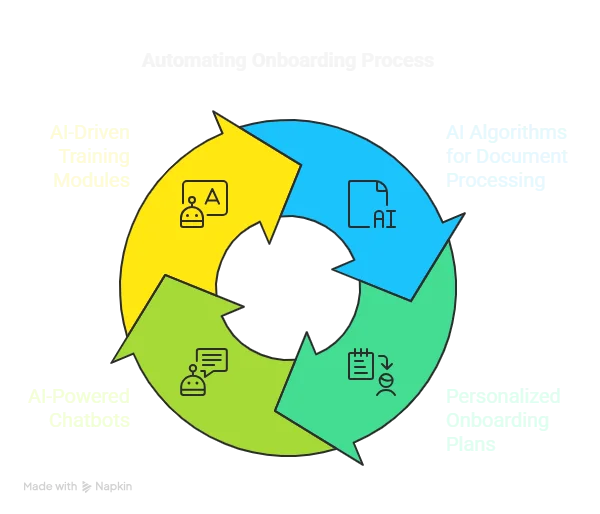
How Do You Automate an Onboarding Process?
Deploying new technologies that simplify tasks, improve efficiency, and enhance the overall experience of new employees can automate the onboarding process. Studies have shown that positive experiences in the first 90 days at a workplace can increase employees’ likelihood of staying up to 10 times.
Now, let’s discuss a few key strategies and advancements that make AI for onboarding a prolific tool in HR practices:
1. AI Algorithms for Document Processing
The integration of AI algorithms has revolutionized traditional practices, offering enhanced efficiency and accuracy to streamline the onboarding process. Let’s discuss some of the key advantages of AI algorithms for document processing:
- Automated Onboarding: Advanced AI algorithms can be used to verify and process the necessary onboarding documents.
- Reduction of Manual Errors: Automated onboarding processes significantly reduce the possibility of manual errors, which become inevitable over time when using traditional document verification methods.
2. Personalized Onboarding Plans
As organizations recognize the potential of automating employee onboarding AI processes, they pave the way for customizable and personalized onboarding experiences. Using AI algorithms enables in-depth analytic insights into new employee information:
- Analytic Insights on Employee Information: AI Employee onboarding automation analyzes new employee information, including roles, preferences, and skill sets. This provides a comprehensive understanding of every employee and creates adaptive learning paths for future growth.
- Individually Catered Onboarding: This analysis can accelerate the generation of individualized onboarding plans based on the needs of every new employee. This makes the onboarding process much easier and ensures a smooth transition of employees into the company’s work culture.
3. The Integration of AI-Powered Chatbots
AI-powered chatbots are a convenient solution to ensure new employees receive the proper support during a transitional phase. Let’s go further into the advantages of utilizing AI-powered chatbots:
- Convenient FAQ Resource: Incorporating artificial intelligence in HR by implementing chatbots allows for easy resolutions to frequently asked questions, making them accessible to new employees.
- Real-time Assistance: Chatbots can be implemented to ensure that the support of new employees is timely, so they can be assured of receiving prompt support during the transitional period, hence leading to a more responsive onboarding experience.
- Reducing Onboarding Bottlenecks: AI-powered chatbots will reduce bottlenecks and smoothen the onboarding experience because they handle common issues.
4. AI-Driven Training Modules
Training modules and learning platforms developed with AI cater to individual learning styles, ensuring that training evolves with the unique needs of each employee. Let’s explore the key facets of AI-driven training modules:
- Adaptive Learning Experiences: AI-developed training modules allow employee training to adapt to all employees’ learning differences and progress and create more nuanced learning opportunities beyond the initial onboarding.
- Targeted Information: AI-facilitated training ensures that new hires receive relevant and targeted information, effectively removing hurdles in the onboarding process.
- Reskilling and Training: AI-facilitated employee training helps ensure new hires receive relevant and targeted information to remove any hurdles in the onboarding process. According to the IBM Global Adoption Index 2022, 35% of organizations are training and reskilling employees to use new AI and automation software and tools.

The Benefits of Tech-Powered Onboarding
Tech-powered onboarding offers several benefits over traditional onboarding methods. Here are some of the key advantages:
1. Improved Employee Engagement and Retention
Technology can make new hire onboarding more interactive, personalized, and engaging. For example, onboarding software can provide gamified learning modules, feedback mechanisms, and social networking features that motivate and connect new hires.
Technology can also reduce the anxiety of new hires by providing them with clear and consistent information, guidance, and support throughout the onboarding process. According to a recent study, employees who had effective onboarding feel up to 18 times more committed to their workplace.
2. Enhanced Learning and Development
Technology can enable new hires to learn at their own pace, style, and convenience. For example, onboarding software can offer self-paced online courses, video tutorials, and interactive quizzes that cater to different learning preferences and needs.
3. Streamlined Administrative Tasks
Technology can automate and simplify the administrative tasks involved in onboarding, such as collecting documents, verifying credentials, and enrolling in benefits.
For example, onboarding software can integrate with other HR systems, such as payroll, performance management, and learning management, to create a seamless and paperless workflow. Technology can also provide analytics and reports that help HR professionals monitor and evaluate the effectiveness of the onboarding process.
4. Increased Innovation and Adaptability
Technology can help new hires adapt to the changing needs and expectations of the organization and the market. For example, onboarding software can provide continuous learning opportunities, such as micro-learning, webinars, and podcasts, that keep new hires updated on the latest trends and developments.
The Role of AI in Onboarding Automation
AI-driven onboarding tools can help automate many administrative tasks associated with onboarding.
Here are some of the key benefits of AI-powered onboarding:
- Personalizing the Onboarding Experience: AI-powered onboarding can help personalize the experience by providing tailored content and support based on the employee’s role, department, and learning style. This can help improve engagement and retention rates.
- Automating Mundane Tasks: AI can also help automate mundane tasks such as data entry, paperwork, and compliance training. This frees up HR staff to focus on more strategic tasks and improves the overall efficiency of the onboarding process.
- Providing Real-Time Support: AI-powered chatbots and virtual assistants can provide new hires with real-time support, answering questions and providing guidance throughout onboarding.
- Analyzing Data for Insights: AI employee onboarding solutions can help collect and analyze data from the onboarding process, such as completion rates, satisfaction scores, and performance indicators. This can help identify areas of improvement and optimize the onboarding program for future hires.
- Improving Talent Retention: AI can help reduce employee turnover by ensuring a smooth and positive onboarding experience. It can also help monitor and address new hires’ issues or challenges, such as role clarity, expectations, and goals.
The Power of Gamification in Employee Training
Gamification is the use of game mechanics and design elements in non-game contexts. In the context of employee training, gamification can help improve engagement, motivation, and learning outcomes.
Here are some of the key benefits of gamified training programs:
1. Increasing Engagement and Motivation
Gamification can increase engagement and motivation by making training more fun and interactive. Companies can create a more engaging and competitive learning environment by incorporating game mechanics such as points, badges, and leaderboards.
2. Encouraging Behavioral Change
Gamification in employee training can also help encourage behavioral change by rewarding positive behaviors and discouraging negative ones. For example, companies can use gamification to encourage employees to complete compliance training or adopt new work habits.
3. Enhancing Learning Outcomes
It can help enhance learning outcomes by improving knowledge retention and skill development. Game mechanics such as repetition, feedback, and rewards help create more effective and engaging training programs.
4. Improving Collaboration and Communication
Gamification can help improve collaboration and communication among employees by fostering a sense of teamwork and social learning. Challenges, quests, and leaderboards can create a collaborative and supportive learning environment.
5. Increasing Innovation and Creativity
Gamification can also increase innovation and creativity among employees by stimulating their curiosity and problem-solving skills. Companies can create a challenging and immersive learning environment by incorporating game elements such as scenarios, simulations, and puzzles.
6. Boosting Employee Satisfaction and Loyalty
Lastly, gamification can help boost employee satisfaction and loyalty by creating a positive and rewarding learning experience. Game features such as rewards, badges, and certificates can help companies establish a system of acknowledgment and gratitude for their employees.
Best Practices for Tech-Powered Onboarding
Here are some best practices for implementing tech-powered onboarding:
- Choose the Right AI-Driven Onboarding Tools: When choosing AI-driven onboarding tools, it’s important to consider factors such as ease of use, scalability, and integration with existing HR systems.
- Design Effective Gamified Training Programs: To design effective gamified training programs, companies should create engaging and interactive content that aligns with the company’s culture and values.
- Measure the Success of Onboarding Automation: To measure the success of onboarding automation, companies should track metrics such as time-to-productivity, employee engagement, and retention rates.
How to Design a Well-Thought 30-60-90-Day Plan?
Here’s how you can design a well-thought-out 30-60-90-day plan for new hires:
1. Build a Roadmap for New Hire Onboarding
Before crafting an employee orientation plan, ensure the new hires can easily fit into your company’s mission and vision. To build a roadmap, start by brainstorming questions like:
- What are the expectations of a new hire for a particular role?
- Do you want to hire new employees to solve a specific problem?
- What are the roles and responsibilities of a new hire?
These questions will create a better plan for new hires to acclimate to the company culture and build the necessary skills for the role.
2. Look at the Bigger Picture
The ultimate purpose of a 30-60-90 day plan is to help new hires align with the company’s business objectives. So, make sure you look at the big picture. For example, the metrics should focus on actual output rather than training.
3. Set Smart and Flexible Goals
Goal setting is the key to a successful 30-60-90 day onboarding process. Easy goals will take productivity down.
The secret is to set SMART and stretch goals that are challenging, realistic, and achievable. Progressive goals make new hires more productive and allow them to develop a strong skill set, which can be beneficial in the long term.
4. Review the Milestones Regularly
What new hires accomplish during the first 90 days lays the foundation for their success in the organization. However, it’s important to keep the plan flexible. The new hires may have to work on tasks not mentioned in the plan.
Therefore, review milestones regularly in the first few weeks. This will allow you to iterate the plan to accommodate additional assignments and track the progress accordingly.
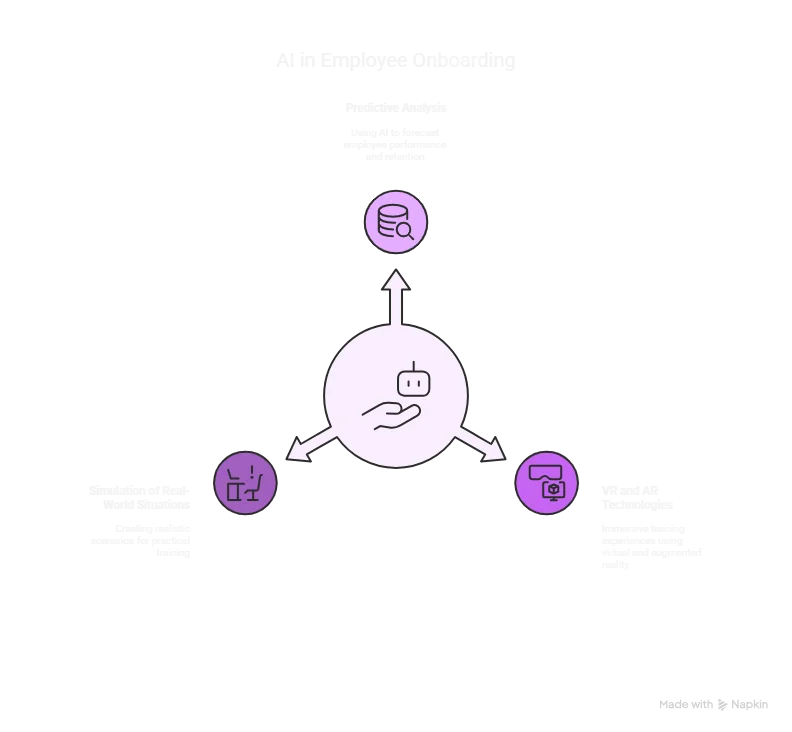
The Future of AI in Employee Onboarding
Efficient employee onboarding ensures a smooth transition for new hires and drives productivity. Traditional onboarding processes can be time-consuming, manual, and often lack personalization. Many organizations are turning to AI-powered solutions to address these challenges and streamline and enhance their onboarding processes.
According to a recent study by Capgemini, 77% of organizations are investing in AI to improve employee experience. AI can help companies automate routine work, tailor the onboarding experience, and collect valuable insights to optimize the onboarding strategy.
As the technology progresses, the application of AI in employee onboarding will evolve, too. Some technologies that will potentially define the future of employee onboarding are as follows:
1. Predictive Analysis
Predictive analytics should predict what new employees will likely want or need. Analyzing data to identify trends indicates what will likely go wrong in this onboarding process and helps avoid such issues.
2. VR and AR Technologies
Virtual and Augmented Reality may create an AI-driven onboarding process that immerses new hires in their workplace. The employees can navigate the workplace virtually and practically, increasing their knowledge about the organization’s framework.
3. Simulation of Real-World Situations
This technology simulates real-world scenarios to provide a more comprehensive understanding of job roles. It accelerates learning and helps employees develop experience as they face the simulated challenges.
Conclusion
Tech-powered onboarding is the future of employee onboarding. By leveraging AI-driven onboarding tools and gamification techniques, companies can create more engaging, effective, and efficient onboarding experiences that improve employee engagement, retention, and productivity.
Partner with Hurix Digital to explore how our tailored solutions can revolutionize your onboarding process. With our expertise, you can redefine the onboarding journey, seamlessly blending technological innovation with a human touch.
Connect with us for more details!
Summarize with:

Senior Vice President – Business Development
at Hurix Digital, with over 25 years of experience in EdTech and workforce learning. He excels in business development, customer relationship management, and scaling digital learning solutions, driving global growth through innovative content, simulations, and AI‑driven training offerings
 Upcoming Masterclass | Build an Army of Brand Evangelists using Training & Development | November 20th, 8:30 AM PDT | 11:30 AM EDT | 10:00 PM IST
Upcoming Masterclass | Build an Army of Brand Evangelists using Training & Development | November 20th, 8:30 AM PDT | 11:30 AM EDT | 10:00 PM IST

